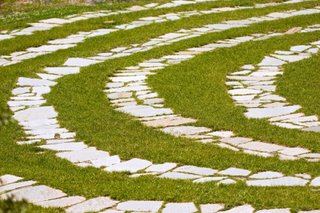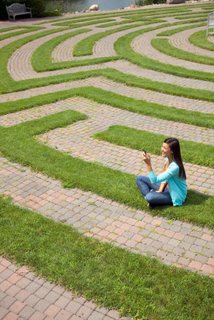
Labyrinth, meditative walking
St. Augustine, a fourth-century theologian, once proclaimed, “Solvitur ambulando”, or “It is solved by walking.”
In few lives is that statement more compelling than in Ellen McDermott’s. In November 1993 a stroke left the San Francisco resident impaired on her left side. She turned to labyrinths, a form of walking meditation, for healing. “I was drawn to labyrinths before my stroke because of their soothing meditative quality, but after the stroke I needed healing and the labyrinth became even more important then,” she says. “In my recovery I used conventional medicine, physical therapy, prayer and other spiritual practices, but walking the labyrinth was different. It was definitely unifying—the one thing that brought all the different aspects of healing together,” McDermott says.
Over several months of walking the well-known labyrinth at San Francisco’s Grace Cathedral, McDermott regained her physical strength. But the healing went much deeper. “Walking the labyrinth helped me move beyond my physical body to find comfort, peace and confidence. I guess you could say it healed all of me,” she says.
One path, endless potential
As one of more than a million people in this country who have walked a labyrinth, McDermott joins many pilgrims past and present who have found solace and strength through labyrinth journeys.
To walk a labyrinth, it’s necessary to follow a path through an intricate pattern until you reach the center. Many people confuse labyrinths with mazes, yet critical differences separate the two. Mazes are “multicursal,” which means you must choose among many possible paths once you enter, explains Helen Curry, author of The Way of the Labyrinth: A Powerful Meditation for Everyday Life (Penguin Compass, 2000). Wrong turns and blind alleys are common in mazes, so is getting lost or disoriented, she adds. Whereas mazes are mental, linear, left-brained experiences, a labyrinth’s path is soothing, rhythmic and meditative, says Curry, who alsois the founding president of the global Labyrinth Society and executive director of The Labyrinth Project of Connecticut Inc. It’s not possible to get lost in a labyrinth. Although some turns take you away from the center, your path is nonetheless sure, safe and gently guided, both in and back out again.
Labyrinths can be made of cloth or bricks; carved into stone floors, hillsides or walls; cut into living garden turf; or even woven into baskets. Circular labyrinths have a varying number of concentric rings, or circuits. The seven-circuit design (pictured below) is the oldest, dating back several thousand years, according to the Rev. Lauren Artress, president and founder of the nonprofit organization Veriditas, The Voice of the Labyrinth Movement and author of Walking a Sacred Path: Rediscovering the Labyrinth as a Spiritual Tool (Riverhead Books, 1996). The 11-circuit version (pictured on page 43), like the world-renowned labyrinth at the Cathedral of Chartres in France, most likely became well known around the 9th century. Recently, Curry developed a smaller three-circuit design for use in ceremonies such as weddings.
As a walking meditation, a labyrinth is similar to sitting meditations in its healing capacity, yet wonderfully different in its accessibility. “For me, walking the labyrinth is more available and effective than sitting meditation,” Artress says. “It makes quieting my mind and being able to harness the power of concentration much easier.”

a spiritual practice, mindfulness walking
Anchored in history, reborn in the present
“No one is quite sure how and where labyrinths were born,” Artress says, “but of the 80 cathedrals that went up in the Middle Ages, we do know that 22 of them had labyrinths.” Some evidence suggests these medieval church labyrinths were used symbolically to represent the journey to God. Other stories passed down through generations indicate ancient cultures from Rome to Scandinavia used labyrinths for good fortune, protection or healing.
“In the United States we’ve seen quite a strong labyrinth revival over the last 15 years,” says Sudha Carolyn Lundeen, CHN, RN, a certified holistic health nurse and the labyrinth workshop leader at the Kripalu Center for Yoga and Health in Lenox, Mass. But as Artress notes, it wasn’t until 1998 that the New York Times officially labeled this revival “The Labyrinth Movement.”
“There are now more than 1,600 labyrinths in the worldwide locator’s database,” Curry says. “And more added daily in prisons, private and public gardens, schools and hospitals.”

labyrinth by the sea
Why labyrinths now?
People are hungry for a richly symbolic life, especially for symbols that offer meaning and comfort, Artress explains. And “as an archetype of wholeness and unity as well as a metaphor for life’s path, the labyrinth…offers a spiritual experience not tied to any particular religion or culture,” she says.
“The labyrinth also offers much-needed psychospiritual healing,” Artress notes. And sometimes it even helps identify issues that need attention. “When those issues surface,” she says, “it’s important to go in and visit them. What are they trying to tell you?”
One night, Barbara Stephen Davis, an English-as-Second-Language teacher in Galveston, Tex., learned how physical feelings can speak volumes within the labyrinth’s sacred space. Even though she normally looked forward to the walks, Davis, also a labyrinth facilitator, felt reluctant to participate that evening in the full-moon labyrinth walk at the University of Texas Medical Branch campus. “It was 2004 and a stressful time in my life,” she explains. “I was processing through some personal issues, working long hours and definitely not taking good care of myself.” To top it off, the back pain that had plagued her periodically was particularly intense that night. “In retrospect I can see I was burned out and repressing a lot of feelings. Who knows, maybe the back pain was a physical metaphor for my life pain,” she says.
“But the moon was amazing, very full, bright and a glowing white,” Davis continues. Captivated by the evening, she did walk after all. Yet with every turn of the labyrinth’s path, the tightness in her back worsened. Even though it didn’t make sense given her physical condition, something told Davis to sit awhile once she reached the labyrinth’s center. “I can’t really explain what happened while sitting there,” she says, “except that I felt somehow outside myself as I yielded to the clouds going back and forth across the moon.” Yet the real gift came when she got up to make her way out of the labyrinth. Her back pain was completely gone, and so far it has never returned. “It was like the labyrinth helped me see the pain in my life and release it,” Davis notes.
Guidelines for the journey
To realize the labyrinth’s potential in your life, simply walk it and let the event unfold. There is no right or wrong way to walk a labyrinth, Curry says, but there are some guidelines that may enrich your journey. Start by quieting your mind and deciding what you hope to gain from the experience. Are you seeking an answer to a question or guidance on a life decision? Perhaps you’re using the opportunity as a celebration or part of a spiritual ritual. Whatever the purpose, use it as your intention while guarding against expectations.
Healing is a very individual process, Californian McDermott notes, and not everyone thinks about his or her walk in stages. “I did, though,” she says, “and as I walked into the labyrinth I learned to let go of all the anger and frustration I felt over not being myself. My quiet time in the labyrinth’s center helped me regain my own center, and the path out was like my path in life, learning to go forward from here.”
Although some walks are life changing, they don’t all have to be dramatic, she says. “It’s the sureness of the labyrinth’s path that I count on when the rest of my life is uncertain. It’s like going home.”
The labyrinth as a healing tool
Scientific research delving into the labyrinth’s healing powers is just beginning, and, in a ground-breaking pilot study conducted at the University of Texas Medical Branch (UTMB) in Galveston, Texas, M. Kay Sandor, PhD, RN, recently became the first researcher to document evidence of its rejuvenating capacity. Sandor, an associate professor in the School of Nursing at UTMB and a nurse psychotherapist, explains that the study found a small decrease in breathing rate and improvements in mood profiles of the participants, after the labyrinth walk.

grass labyrinth
Meanwhile, progressive hospitals didn’t wait for research proof before providing a labyrinth for their patients and staff. In 1998, California Pacific Medical Center (CPMC) in San Francisco became the first U.S. hospital to construct a labyrinth on their grounds, says Dennis Kenny, director of the CPMC Institute for Health and Healing’s Integrative Clinical Education and Spirituality Program. Others have followed, like Mercy Hospital Grayling in Grayling, Mich., and Legacy Meridian Park Hospital in Tualatin, Ore. “We made the labyrinth accessible to anyone, placing it at the entrance to the hospital, right outside our main lobby and waiting area,” Kenny says. “Cutting across spiritual beliefs and backgrounds, it provides a respite for patients, patient families and hospital staff when they most need comfort and peace. In a setting like this, the labyrinth’s symbolic message is powerfully clear,” he says. “There is a sanctuary for you here, and we care for much more than just your body parts.”
Posted in Chime Alarm Clocks, intention